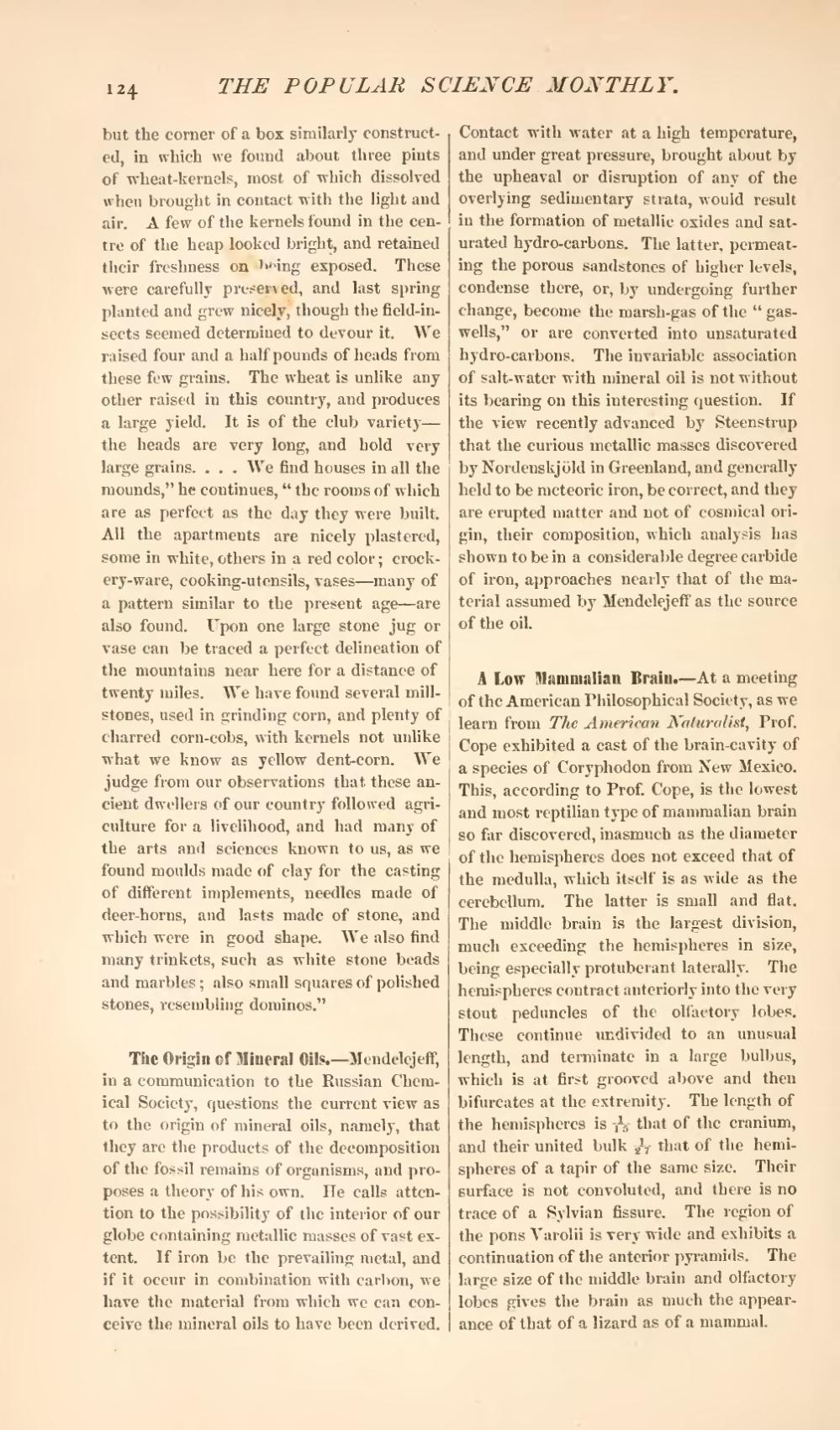but the corner of a box similarly constructed, in which we found about three pints of wheat-kernels, most of which dissolved when brought in contact with the light and air. A few of the kernels found in the centre of the heap looked bright, and retained their freshness on being exposed. These were carefully preserved, and last spring planted and grew nicely, though the field-insects seemed determined to devour it. We raised four and a half pounds of heads from these few grains. The wheat is unlike any other raised in this country, and produces a large yield. It is of the club variety—the heads are very long, and hold very large grains. . . . We find houses in all the mounds," he continues, "the rooms of which are as perfect as the day they were built. All the apartments are nicely plastered, some in white, others in a red color; crockery-ware, cooking-utensils, vases—many of a pattern similar to the present age—are also found. Upon one large stone jug or vase can be traced a perfect delineation of the mountains near here for a distance of twenty miles. We have found several millstones, used in grinding corn, and plenty of charred corn-cobs, with kernels not unlike what we know as yellow dent-corn. We judge from our observations that these ancient dwellers of our country followed agriculture for a livelihood, and had many of the arts and sciences known to us, as we found moulds made of clay for the casting of different implements, needles made of deer-horns, and lasts made of stone, and which were in good shape. We also find many trinkets, such as white stone beads and marbles; also small squares of polished stones, resembling dominos."
The Origin of Mineral Oils.—Mendelejeff, in a communication to the Russian Chemical Society, questions the current view as to the origin of mineral oils, namely, that they are the products of the decomposition of the fossil remains of organisms, and proposes a theory of his own. He calls attention to the possibility of the interior of our globe containing metallic masses of vast extent. If iron be the prevailing metal, and if it occur in combination with carbon, we have the material from which we can conceive the mineral oils to have been derived. Contact with water at a high temperature, and under great pressure, brought about by the upheaval or disruption of any of the overlying sedimentary strata, would result in the formation of metallic oxides and saturated hydro-carbons. The latter, permeating the porous sandstones of higher levels, condense there, or, by undergoing further change, become the marsh-gas of the "gas-wells," or are converted into unsaturated hydro-carbons. The invariable association of salt-water with mineral oil is not without its bearing on this interesting question. If the view recently advanced by Steenstrup that the curious metallic masses discovered by Nordenskjöld in Greenland, and generally held to be meteoric iron, be correct, and they are erupted matter and not of cosmical origin, their composition, which analysis has shown to be in a considerable degree carbide of iron, approaches nearly that of the material assumed by Mendelejeff as the source of the oil.
A Low Mammalian Brain.—At a meeting of the American Philosophical Society, as we learn from The American Naturalist, Prof. Cope exhibited a cast of the brain-cavity of a species of Coryphodon from New Mexico. This, according to Prof. Cope, is the lowest and most reptilian type of mammalian brain so far discovered, inasmuch as the diameter of the hemispheres does not exceed that of the medulla, which itself is as wide as the cerebellum. The latter is small and flat. The middle brain is the largest division, much exceeding the hemispheres in size, being especially protuberant laterally. The hemispheres contract anteriorly into the very stout peduncles of the olfactory lobes. These continue undivided to an unusual length, and terminate in a large bulbus, which is at first grooved above and then bifurcates at the extremity. The length of the hemispheres is 115 that of the cranium, and their united bulk 127 that of the hemispheres of a tapir of the same size. Their surface is not convoluted, and there is no trace of a Sylvian fissure. The region of the pons Varolii is very wide and exhibits a continuation of the anterior pyramids. The large size of the middle brain and olfactory lobes gives the brain as much the appearance of that of a lizard as of a mammal.
